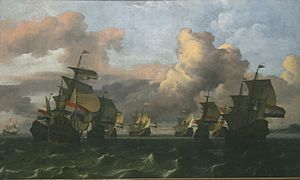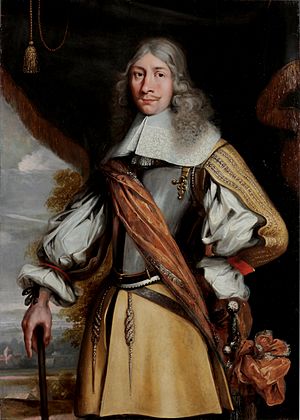Battle of Masulipatnam facts for kids
Quick facts for kids Battle of Masulipatnam |
|||||||
|---|---|---|---|---|---|---|---|
| Part of Third Anglo-Dutch War and Franco-Dutch War | |||||||
 Returning fleet of the Dutch East India Company (1675), by Ludolf Bakhuysen |
|||||||
|
|||||||
| Belligerents | |||||||
| Commanders and leaders | |||||||
| Strength | |||||||
| 13 warships | 10 warships | ||||||
| Casualties and losses | |||||||
| light | 3 ships captured 360 killed, wounded or taken prisoner |
||||||
The Battle of Masulipatnam was an important naval battle. It happened between two powerful trading companies: the Dutch East India Company (VOC) and the English East India Company (EIC). This fight took place in India, near a town called Machilipatnam. It was part of a bigger conflict called the Franco-Dutch War. During a siege near São Tomé, 13 Dutch ships fought against 10 English ships. The Dutch ships won this battle.
Contents
Why the Battle Happened
Even before the main Franco-Dutch War started, France sent a strong navy group to Asia in 1671. This group was led by Admiral de la Haye. France knew war with the Dutch Republic was coming. They wanted to be ready to strike when the war began.
Admiral de la Haye was told to find a strong base in Asia. He captured Trincomalee in March 1672. This was a very important bay on Ceylon's east coast. Then, in July 1672, the French took São Tomé from the Dutch.
Problems with São Tomé
Taking São Tomé caused some problems for the French. The Portuguese government still wanted the town back. It used to be a Portuguese town. São Tomé was also very close to Madras. Madras was a key English trading post. The French taking São Tomé made their English allies upset. It put a strong rival right next to an important English area.
Also, by taking São Tomé, the French angered the local ruler. This was Abul Hasan Qutb Shah, the sultan of Golconda. Golconda was the true owner of the city. The sultan raised an army. They began to surround São Tomé in the summer of 1672.
The French managed to break this first siege. But by June 1673, the Dutch joined forces with the Golconda army. The Dutch had secured their own areas. They had beaten the French at Trincomalee. So, São Tomé was surrounded again. The Golconda army attacked by land. The Dutch fleet, led by Rijcklof van Goens, attacked from the sea.
The Battle Begins
During the siege of São Tomé, an English fleet appeared. This fleet had ten strong ships from the English East India Company. They were led by William Basse. This English fleet could have joined the French navy. Together, they might have helped São Tomé. They could have tried to push the Dutch out.
But the English chose not to help. They stayed on their own. Meanwhile, the Dutch commander, Van Goens, did not know about the English fleet. He had sent 13 Dutch East India Company ships to Masulipatnam. This was an important Dutch trading post. It was north of São Tomé. Van Goens wanted to protect it from French attacks.
Fighting at Sea
The Dutch fleet was commanded by Cornelis van Quaelberg. On September 1, 1673 (or August 22, 1673 by an older calendar), he met the British fleet. They met about five or six miles from Masulipatnam. The battle started quickly. Both sides fought very hard.
After about three or four hours, the Dutch won. They captured three English ships. One was the English Vice-Admiral's ship, with 40 guns. Another was the Rear-Admiral's ship, with 34 guns. The third had 36 guns. The remaining English ships were chased away. They soon left the Indian seas completely.
Captain Basse's Story
English Captain Basse was the admiral of his squadron. He wrote a detailed report of the battle in his ship's log. His ship was called the London. He wrote that the battle began at 10 AM.
Captain Earwin led Basse's front ships. He left the fight after about two hours. Captain Cruft's ship followed him. Cruft's ship had been hit below the water. Neither ship rejoined the battle. Basse did not know why Cruft left.
Captain Westlock did not fight at all that day. He stayed behind Captain Hides's ship. Hides was the Vice-Admiral. Westlock stayed on the safer side of the battle line. Hides's ship was badly damaged around 5:30 PM. Then, three Dutch ships surrounded him. Two Dutch ships boarded his ship. Hides's ship was captured. Captain Earning's ship (the Rear-Admiral) was also taken. The Antelope, led by Captain Goldsborough, was captured too.
Basse's own ship had its rigging shot away. The Dutch fired chains and many small cannonballs at once. This made their broadsides very powerful. His main mast was hit in three places. Things got worse when gunpowder exploded on his ship. This caused fires, which were put out quickly. Eighteen men were killed or wounded.
Even so, Basse kept firing. But he had to turn away to save his own ship. He could not help Captain Hides. He said he had nine more wounded men on the gundeck. These injuries were mostly from splinters. Other ships in his group did not help him. Only Captain Browne's ship, which was also damaged, stayed near. Basse praised Browne for his bravery. Other captains, like Coolys, did not fight at all. Coolys said he had no ammunition.
The Dutch stopped chasing the English ships around 6:30 PM. The English sailors were very tired. They only managed to fix some of their sails. The small boats of the London were also destroyed. The next morning, Basse met Captains Earwin and Browne. They had dinner on Browne's ship. They decided to sail south of São Tomé. They were afraid of meeting the Dutch again. On the London, several wounded men died from their injuries.
What Happened Next
The siege of São Tomé continued until late August 1674. The French soldiers there finally gave up to Van Goens. They ran out of food and gunpowder. The Dutch had agreed with the sultan of Golconda to return the town. They also agreed to tear it down. So, the Dutch did not keep the port.
This was good news for the English in Madras. They really wanted the nearby town destroyed. They even wrote to the sultan, asking him to demolish it quickly. Even with the war, the French and English trading companies could not seriously weaken the Dutch East India Company. The Dutch kept their strong position in trade routes across the ocean and within Asia.
Images for kids



